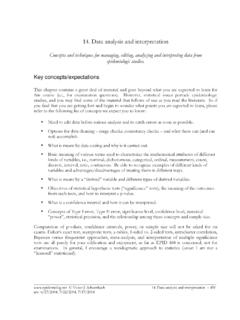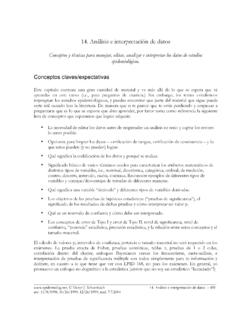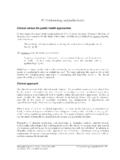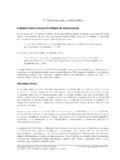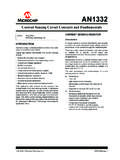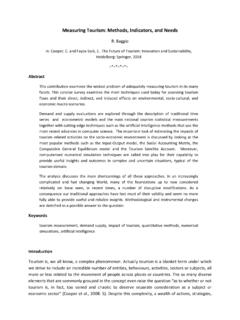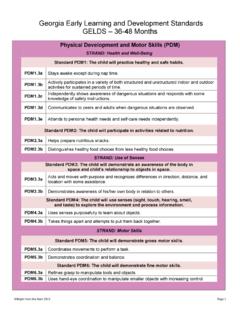Transcription of 3. Studying populations basic demography
1 _____ , Victor J. Schoenbach 1999, 2000 3. Studying populations - basic demography - 31 rev. 2/16/2004, 10/14/2004, 8/28/2007 3. Studying populations basic demography Some basic concepts and techniques from demography - population growth, population characteristics, measures of mortality and fertility, life tables, cohort effects. The demi in epidemiology Since the primary subject matter of epidemiology is people (except for veterinary epidemiologists, who apply the same concepts and methods to Studying other animal populations ), a logical place to begin the study of epidemiology is with some basic concepts of demography . population growth an epidemic of homo sapiens* For its first few million years, the species that we refer to as homo sapiens numbered probably fewer than 10 million, due to high mortality.
2 In about 8000 , with the beginning of agriculture, significant population growth began, bringing world population to about 500 million over a 6000-year period. At that point (1650 AD), growth accelerated sharply, so that world population doubled in 150 years (1 billion in 1800), doubled again in 130 years (1930), and doubled yet again in 45 years (4 billion in 1975). Every decade the world s population increases by about 1 billion, mostly in the developing countries. The population will reach 6 billion in early 1999. It is projected to reach billion by 2030 and billion by 2100. World population in mid-1997 (millions) Region population Asia 3,552 Africa 743 Europe 729 Latin America & Caribbean 490 North America 298 Oceania (Australia, NZ, and Pacific) 29 World 5,840 (does not add due to rounding) * Note about sources: Much of the following has been drawn from publications by the population Reference Bureau (PRB), especially population : A lively introduction and The future of world population (see bibliography).
3 This table comes from their 1997 World population data sheet. The PRB web site ( ) has a wealth of data and links to sources of information on population - and health-related topics. _____ , Victor J. Schoenbach 1999, 2000 3. Studying populations - basic demography - 32 rev. 2/16/2004, 10/14/2004, 8/28/2007 In 1997, 86 million more people lived on planet Earth than the previous year, for an estimated annual world population growth rate of At that rate, world population would double in 47 years. The world population growth rate is the difference between the birth rate of 24 per 1,000 people and the death rate of 9. Over the time, differing growth rates can dramatically alter the age, geographic, racial, and affluence distribution of the world s population .
4 In 1950, two thirds of the world s population lived in what is usually referred to as the developing world. The proportion was three-quarters in 1990 and is projected to grow to 85% by 2025 and 90% by 2100. Thus, whatever improvements in health take place in the industrialized world, world demographic and health indicators will be primarily influenced by the situation in the developing world. The Demographic Transition A fundamental model developed to describe population dynamics is the Demographic Transition model. The model posits four stages in the evolution of the population in a society. 1. High fertility, high mortality (pre-industrial) 2. High fertility, declining mortality (industrializing) 3.
5 Declining fertility, low mortality 4. Low fertility, low mortality (stable population ) The first stage (pre-industrial) prevailed throughout the world prior to the past few centuries. Rapid population growth takes place in Stages 2 and 3, because high birth rates, necessary for population survival in Stage 1, are embedded in the cultural, religious, economic, and political fabric of pre-modern societies. As economic and public health advances decrease mortality rates, rapid population growth occurs until the society adjusts to the new realities and fertility decline. The Demographic Transition Model was constructed from the European experience, in which the decline in death rates was gradual.
6 It remains to be seen how this model will play out in the developing world of today, in which the decline in death rates has occurred much more rapidly and in which social change takes place against a backdrop of and in interaction with the post-industrial world of electronic communications, multi-national production and marketing, and international travel. There is some evidence that the model will also apply to the developing world of today. But the timetable for completion of the demographic transition in the developing world will determine the ultimate size of the world s population . Demographic balancing equation If birth and death are the two most fundamental demographic processes, migration is probably the third.
7 The size of the world s population is (at least at present) completely determined by birth and death rates, but the population in any particular region or locale is also determined by net migration. These three processes are expressed in the demographic balancing equation the increase (or decrease) in a population as the algebraic sum of births, deaths, immigration, and emigration. The following table gives the equation for the world and for the for 1991. _____ , Victor J. Schoenbach 1999, 2000 3. Studying populations - basic demography - 33 rev. 2/16/2004, 10/14/2004, 8/28/2007 The demographic balancing equation for the United States (from McFalls, 1991) (numbers in thousands) Starting population + ( Births Deaths ) + ( Immigration Emigration ) = Ending population Starting population + (Natural increase) + (Net migration) = Ending population World = 5,245,071 + (142,959 50,418) = 5,245,071 + 92,541 = 5,337,612 = 248,168 + (4,179 2,162) + (853 160) = 248,168 + 2,107 + 693 = 250,878 In recent decades, on a world basis, the migration has perhaps had its greatest impact on urbanization.
8 In the forty years from 1950 to 1990, the urban population in the countries of the Third World increased over five-fold, from 286 million to about billion. About 40 percent of this growth resulted from rural to urban migration. The predicts that by the year 2000 there will be 19 Third World cities with populations over 10 million. In contrast to Tokyo, Los Angeles, New York, London, and other glamorous metropolises, overcrowded urban areas in poor countries are characterized by inadequate housing, sanitation, transportation, employment opportunities, and other essentials of healthy living, the ingredients for misery and the spread of microorganisms. population age structure and the population pyramid For every 10 people in the world: 3 are younger than 15 years of age 4 live in an urban area 6 live in Asia (2 in China, 1 in India) 8 live in developing countries An important dynamic in population growth is the reciprocal relationship between the rate of natural increase (births - deaths) and the age structure of the population .
9 The latter is one of the strongest influences on the growth rate of a population , since both fertility and mortality vary greatly by age. A younger population has a higher rate of natural increase; a high rate of natural increase in turn lowers the median age of a population . In Africa, which has the highest birth (40/1,000) and growth ( ) rates, only 56% of the population are older than 15 years. In contrast, in Europe, where average birth rates have been close to replacement level for many years, four-fifths of the population (81%) are older than 15 years. In fact, Europe as a whole experienced overall negative growth in 1997, due to birth and death rates of 10 and 14, respectively, in Eastern Europe (including Russia).
10 Since nearly all (96%) _____ , Victor J. Schoenbach 1999, 2000 3. Studying populations - basic demography - 34 rev. 2/16/2004, 10/14/2004, 8/28/2007 of the increase in the world s population takes place in the developing world, the developing countries are becoming younger while the wealthier countries are becoming older. Nevertheless, fertility control is increasing in the developing world. As it does, the age structure of the population shifts upwards, since the larger birth cohorts of previous years are followed by relatively smaller birth cohorts. The average age of the world's population , around 28 years, is projected to increase to 31-35 years, so that the proportion of persons 60 years and older will grow from about 9% to 13-17% (Lutz, 1994).


